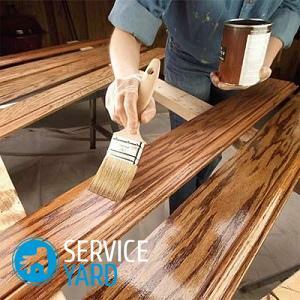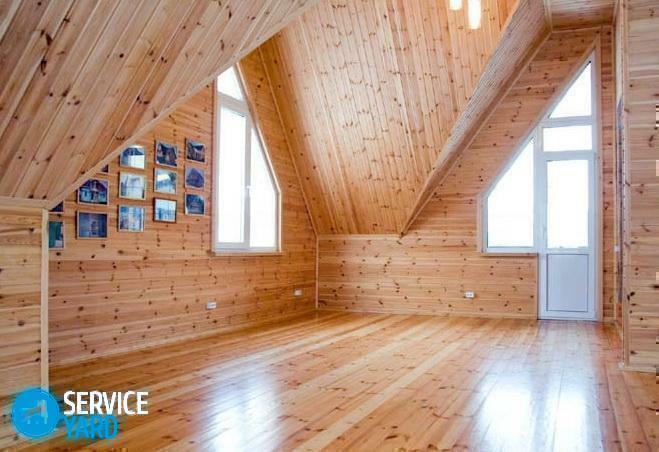
- How do I do the right painting of the lining?
- Preparation of lining for painting
- Primer for lining
- Wood protection
- Coating for lining - paint, lacquer
- Basic criteria for selecting the finish for wooden lining
- Tool for painting lining
- Tips for storing open cans of paint:
Huge number of people around the world for finishing andfacing their homes prefer a beautiful and natural material - a wooden lining. With its ecological compatibility and natural beauty, it not only decorates the room, but also creates a certain favorable microclimate in it. In this article we will tell you the better to cover the lining inside the house to create an attractive interior and protect the coating from darkening, mechanical damage and rotting.
to the contents ↑How to perform the correct painting of the lining?
The seemingly good method of "taking a brush, paint and dye" is by no means suitable. Wood, painted in this way, will not last long. Is not it better to choose a more correct and thorough approach?
Wood lining technology involves a full range of work in 4 main stages:
- Preparation.
- Primer.
- Protection.
- Decorative painting.
Preparation of lining for painting
This stage of construction works will be unnecessary for lining, because European producers operate according to special standards that require mandatory primary treatment of decorative wood panels with protective compounds.
For those who have purchased a standard lining of domestic production or are going to install products with a pre-painted surface, first of all, it is necessary to perform thorough primary processing of wood.
Preparation of a new lining
The preparation of a new wood board that you bought in one of the building material stores includes the following works:
- The lining batch usually allows re-sorting up to 10%, that is, the available material of Class I may contain a small amount of second-boards. In order not to disrupt the integrity of the surface, the lamellas must be carefully viewed and sorted.
- The lining you purchased before the installation should be perfectly dry.
- It is necessary to hold the material in the temperature mode of the room, where you plan to install the wagon board. Of course, bring the temperature to the state of the sauna for "warming" the board does not make sense, but then lie in the room where it will be installed, it should be within 2-3 days.
- Elimination of defects. To defects in the surface of the lining can be attributed roughness, blue, white spots, chips, dead knots. Part of the defects on the panels can not be touched, because in the process of work you will need a short lining - for finishing over the doors and windows. But before starting the installation, the open surfaces of the plates should be cleaned of defects by bleaching.
Important! For such work, the use of "Snez Neo" or "Hoarfrost" is recommended. Fat stains can be removed by de-setting, wiping them with a 25% solution of acetone. With the help of sandpaper or a metal brush, you can remove the roughness.
Preparation of the used lining
Unfortunately, the painting of a wooden lining is not a process that can be carried out only once for the whole period of its service. It must be periodically repeated.
Before painting the lining, covered with varnish, it is necessary to pre-process the boards.
It is usually necessary to re-paint the lining in the following cases:
- the bottom layer of paint has peeled off;
- lamellas lost color;
- paint or varnish lost luster;
- on the surface appeared a significant defect, for example, horrible oil, grease, another dye, solvent or there are fungal injuries;
- the present color of the lining does not fit the new interior of the house.
How to clean the lining from varnish, paint and dirt?
Remove the old lacquer or paint from the surface of the lining in two ways:
- Chemical. It presupposes the use of various synthetic solutions and formulations - washings and softeners, which help the paint flake off the substrate. Note that the chemical method is quite aggressive. After removing the surface layer, it is necessary to wash the lamellas with water or wipe with white spirit.
Important! Carry out work with the use of these funds in a well-ventilated room, using personal protective equipment.
- Mechanical. Now the existing coating is removed using a metal brush, a scraper or a construction hair dryer and a spatula. For complete removal of the paint, the boards must be treated with a solution of soda. A major drawback of this method is the possibility of damaging the lamellae with a brush or scraper.
Important! If you can not decide which method of stripping to prefer, take note of these tips:
- The mechanical method of cleaning the lining is best for removing oil paint.
- If you plan to clean the cleaned surface of the wood with a clear varnish, then it is more advantageous to prefer a mechanical method, since the washings can unevenly bleach the lining.
If there are partial deep defects, they must be sealed with putty. Then apply a layer of paint on the treated area, wait for drying, and then paint the entire surface with the lining.
to content ↑Primer for
lining To impart a uniform structure to the wooden coating, the primer material is applied with a spray or brush.
If priming is applied before painting, this will give the wooden paneling a few undeniable advantages:
- will improve the "grip" of the future surface layer - varnish or paint with wood;
- protects the tree from swelling;
- will close the pores, which will allow to finish the finish more evenly;
- reduces the consumption of decorative coatings - paint or varnish.
Important! Some types of wood, for example, individual species of pine or spruce, are able to allocate resin for a fairly long time. To avoid this, the lining must be treated with a special primer that will close the wood pores.

Types of primers for lining
What is the best way to cover the lining inside the house? The types of the primer depend on the composition. In the current market of building materials, you can find the following types of primer coating:
- Alkyd. This coating is suitable for both outdoor and indoor use. These compounds are adapted to a specific wood species, and therefore their choice is most diverse.
- Acrylic. This compound is a reliable protection against any damage, other than rotting and rust. Such a primer is suitable for use in internal repair.
- Polystyrene primers. In view of the high toxicity, they are suitable only for outdoor work.
- Primer with PVA glue. The well-known PVA adhesive solution, which is prepared in the proportion of 10 drops of glue per 100 ml of water, is applied twice. This is necessary in order to avoid the development of unprimed areas, which will become visible only after complete drying.
Important! Disadvantages of the method: a whitish coating may appear on the wooden lining, such whiteness is not visible on the untreated wood, and on the tinted surface it is very noticeable. Partially hides the structure of the wood.
- Olif. It is a long time known to all the means that gives the wood a stickiness and changes its color. Excellent as a fairly budget option, if you need to cover the lining inside the house.
Important! The primer applied to the surface of the wood should not form a film.
- Gelatin primer. As a primer, some users recommend using food gelatin. Gelatine is soaked in cold water in the proportion of 1 part gelatin to 2 parts water, then heated in a water bath until the granules completely dissolve. Cool the composition to a slight thickening, and cover it with a lining in 2-3 layers.
Important! The best chemical industrial products for priming when restoring the lining are deservedly the following products:
- Tikkurila( Tikkurila);
- Belinka;
- Lacra;
- Pinotex.
Wood protection
To protect the surface from scratches and other damages, it must be coated with a special chemical compound. These funds are designed to protect wood from the effects of moisture, rot, fungal infections, pests and ultraviolet.
Important! Experts recommend always apply wood protection, regardless of whether the wooden lining will be further decorated - paint or varnish.
Methods and means of protection of wood
Specificity of protective agents is that they become invisible when dried and penetrate deeply into the structure of wood. The application of such compounds is a very important stage in the protection of the lining. Manufacturers of lining are applying them at the pre-sale stage of preparation.
Important! To process the primer of the lining, it is better on both sides. The ends of the lamellas need to be given special attention. This is due to the fact that the end side will not be painted after installation.
You can choose such solutions to cover the lining inside the house:
- Flame retardants. Compositions that are made on the basis of aqueous solutions of salts. They are designed to protect products from wood from fire.
Important! The decorative means used by you must also increase the fire resistance of wood.
- Antiseptics. These are chemical compounds that have an active antifungal activity. They are designed to protect the vagonka from the biological activity of various fungi and pests.
Important! Before the installation of the lining, it must be done with antiseptic. This is due to the fact that the reverse side of the wooden bar, which includes ridges and grooves, also needs to be processed.
to the contents ↑Coating for lining - paint, varnish
It is necessary to approach very responsibly to the choice of decorative finish coating - varnish or paint.
While planning repair work, many people are wondering what is preferable to wood lining - paint or varnish? If the paint, which is better for products from natural wood? First you need to determine the location of the work, what effect is expected, what is the quality of the surface to be painted, the requirements for the timing, etc.
So, what is better to cover the lining inside the house at the finish stage?
Paint
There are several types of paints that are quite appropriate in this repair method.
Oil paint:
- Practice shows that the oil-based paint is durable and reliably protects the wood from moisture.
- It slowly changes color and dries quickly.
- This type of paint has a specific odor that disappears when airing.
- This decorative coating on the lining is not difficult to update. Oil paint must be renewed every 5-6 years.
- This procedure should be carried out to eliminate microcracks, through which moisture can damage the carpet and to give the paint a lost gloss.
Important! Initially, you should choose a darker shade of paint. Painted with oil paint the surface of the board after drying will become slightly lighter.
Acrylic or acrylate paint:
- This type of paint is advantageously distinguished by its lack of odor, and high drying speed.
- The use of such formulations does not limit the time of work. It is allowed to apply paint at low temperature.
- Painted with acrylic paint surface lining, long will not need to be updated.
Important! The high price is its only drawback.
Stain - impregnation or decorative azure?
This, in fact, the same primer, after processing which the wood changes color or shade. Inexpensive, but very effective way to emphasize the structure of a tree is the use of stain. An excellent option if you need restoration of the lining.
Important! Use stain can be, if the wood surfaces are not defective.
Varnish for lining
This coating is transparent. If you want to preserve the natural structure of a tree, it becomes an irreplaceable finish coat.
Acrylic shovel for
lining It is a quick-drying and environmentally friendly lacquer that can be diluted with water. It is used for painting wooden lining from the inside and outside, and also does not have a strong odor.
Important! Aqvalakom can be used even for repairs in a house where an allergic person lives.
Alkyd lacquer for lining
This type of lacquer dries long and creates a film on the surface of the panels to be painted.
Such a finishing composition is usually used in premises with a high moisture content - kitchens or corridors, where there is usually an increased wear of the lining.
Important! Covering the lining with yacht varnish is characterized by absolute strength and resistance to UV radiation, but it is better to do this only on the facade.
to the table of contents ↑The main criteria for choosing the final coating for wooden lining
When choosing what to paint with lacquered lacquer inside the house, pay attention to the following characteristics of the proposed finish coatings:
- Manufacturer. Worthy competition to foreign goods can create a lot of domestic manufacturers of paint or varnish for lining. Very pleased that the price of them will be more humane.
- Color. To replace the shade or the color of the lining, you need to use stain. For example, light shades visually increase the space. Zoning the room will help you use different colors and shades.
- Composition. The coating that can be used for interior works has a prefix "bio" after the name of the varnish, which indicates the absence of harmful substances in its composition.
Tool for painting the lining
For the correct painting of wooden slats, you can use the following specialized tools:
- foam sponge;
- a rifle glove for staining or soaking of places where the lining or the tubes are joined;
- atomizer, which gives the ability to quickly cope with the required amount of work;
- roller - allows you to quickly carry out painting, but to obtain a uniform layer you need to paint several times.
Tips for storing open cans of paint:
- To prevent the film from appearing on the paint surface, it is possible to put a board saturated with linseed oil on a surface during a long break.
- If the film has appeared, that it has not got on a painted surface, it is necessary to close a surface with foam rubber and to dunk a brush through it.
- You can get a more saturated tint or color, if the paint is applied several times( up to 4).If you increase the number of layers, it will not have any effect.
- Do not allow paint or varnish to dry very quickly. This can cause cracking of the colored layer. Professionals do not recommend working with paint or lacquer under the influence of direct sunlight.
When we have dealt with the nuances of processing, impregnating and dyeing wood lining, you can start creating a beautiful surface to ensure its long operation.



